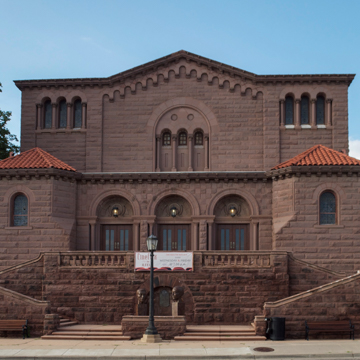You are here
Adele Ilfeld Auditorium
When Springer Hall was destroyed by fire in 1922, the Adele Ilfeld Auditorium became the oldest extant building on the campus of New Mexico Highlands University (formerly New Mexico Normal University). Designed by the Las Vegas architect E.W. Hart, the Ilfeld Auditorium was built to accommodate a rapidly growing university population and to serve as a community civic center that, in the words of Frank Springer, prominent businessman and university regent, would dominate the city “like a temple of beauty and grandeur.”
Indeed, the Ilfeld Auditorium is like a temple, or more precisely, a secular cathedral built to educate and morally elevate the citizens of Las Vegas. Rising on the north side of University Avenue, its prominent two-story facade of local brownstone is a late example of the Romanesque Revival style whose plasticity and sense of structural mass are reminiscent of H.H. Richardson’s Trinity Church in Boston. Three arched entrance portals, between squat polygonal towers at the corners, are reached from either side by double dogleg stairs. The facade then steps back to a central, triple-arched window beneath a gable set off by a corbelled arcade and framed by short towers with arcaded galleries. Behind the facade, the rest of the structure is brick, with tile roofs.
The university’s stylistic image was codified by the Romanesque Revival Springer Hall that Isaac Hamilton Rapp and William Morris Rapp designed in 1897–1898. Required to work in the same idiom, Hart consulted with the Rapp brothers in planning and supervising the auditorium’s construction. In 1917, the New Mexico State Legislature allocated an initial budget of $75,000 for the auditorium’s construction and this was supplemented with a donation of $25,000 from Las Vegas merchant and university regent Charles Ilfeld, in memory of his wife, Adele. Because Hart’s design was more costly than anticipated, the building remained unfinished until 1931, when the Ifeld’s children, Louis, Herman, and Arthur, funded the completion of the interior in memory of their parents following Charles’ death in 1929.
The 10,000-square-foot auditorium seats over seven hundred and continues to operate as a theater venue, educational facility, and congregational space for both New Mexico Highlands University and the city of Las Vegas.
The auditorium has regularly scheduled events and is open to the public.
References
“Ilfeld Auditorium.” New Mexico Highlands University. Accessed January 13, 2015. http://www.nmhu.edu/.
Price, Hugh W. “A History of the New Mexico Normal University (1893–1931).” MA Thesis, New Mexico Normal (Highlands) University, 1932.
Threinen, Ellen. Architecture and Preservation in Las Vegas: A Study of Six Districts. Las Vegas: Design Review Board, City of Las Vegas, New Mexico, 1977.
Writing Credits
If SAH Archipedia has been useful to you, please consider supporting it.
SAH Archipedia tells the story of the United States through its buildings, landscapes, and cities. This freely available resource empowers the public with authoritative knowledge that deepens their understanding and appreciation of the built environment. But the Society of Architectural Historians, which created SAH Archipedia with University of Virginia Press, needs your support to maintain the high-caliber research, writing, photography, cartography, editing, design, and programming that make SAH Archipedia a trusted online resource available to all who value the history of place, heritage tourism, and learning.



















